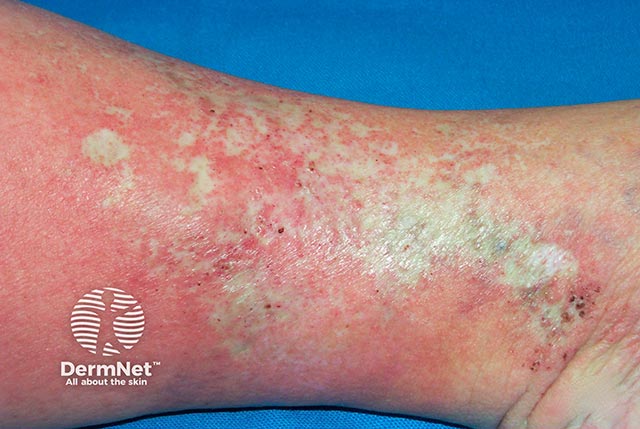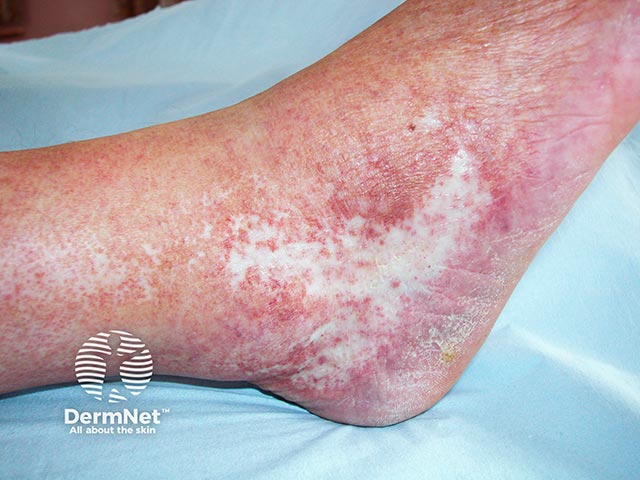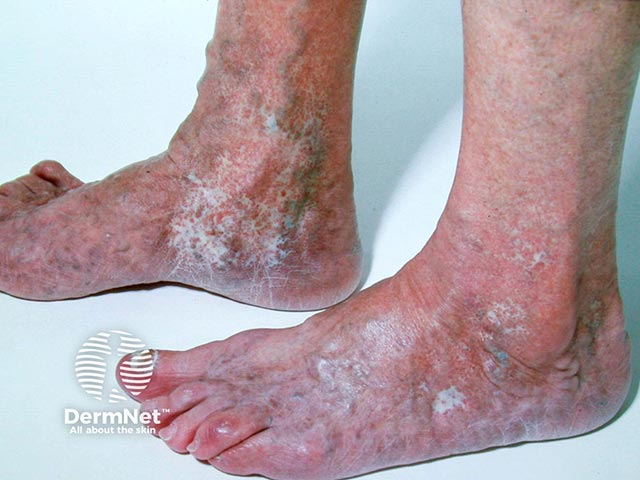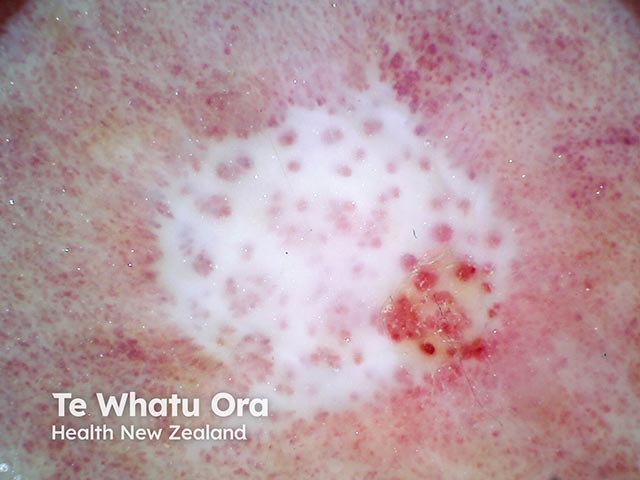Main menu
Common skin conditions

NEWS
Join DermNet PRO
Read more
Quick links
Atrophie blanche — extra information
Atrophie blanche
Last Reviewed: December, 2024
Author(s): Dr Vidette Wong, Specialty Doctor in Dermatology, Northern Ireland, UK (2024)
Previous contributors: Vanessa Ngan, (2004); Dr Ebtisam Elghblawi, Dermatologist, Libya; A/Prof Amanda Oakley, Dermatologist, NZ (2017).
Peer reviewed by: Dr Eunice Chou, New Zealand (2024)
Reviewing dermatologist: Dr Ian Coulson
Edited by the DermNet content department
Introduction
Demographics
Causes
Clinical features
Variation in skin types
Complications
Diagnosis
Treatment
Outlook
What is atrophie blanche?
Atrophie blanche (white atrophy) is the name given to a particular type of scarring with ivory-white plaques accompanied by peripheral hyperpigmentation and telangiectasia. These usually occur on the lower extremities.
Atrophie blanche is a common feature of livedoid vasculopathy. The literature on this may be confusing as some people consider atrophie blanche to be a synonym for livedoid vasculopathy. However, atrophie blanche is more appropriately used to describe the morphologic pattern of scarring that occurs from healed ulcers.

Stellate and reticulate scars resulting in atrophie blanche

Ivory-white scars with dotted vessels in atrophie blanche

Atrophie blanche causing stellate white scars due to venous incompetence

Dermoscopy of atrophie blanche - ivory white scarring and central dot vessels (AB-patient7)
For more images, click here
Who gets atrophie blanche?
Atrophie blanche is an uncommon condition occurring primarily in middle-aged female adults. It is generally associated with patients with chronic venous insufficiency.
What causes atrophie blanche?
Atrophie blanche frequently occurs secondary to a condition called livedoid vasculopathy. Persistent painful ulcers as a result of livedoid vasculopathy leads to recurrent healing and scarring, causing atrophie blanche.
Atrophie blanche can also be due to other causes of recurrent ulceration in the lower limbs such as in:
- Cutaneous small vessel vasculitis
- Diabetic foot ulcer
- Any wound on the lower leg, such as following cryotherapy or curettage and cautery procedures
Atrophie blanche can develop in sites of prior ulceration or in the absence of preceding ulcers.
The pathogenesis of atrophie blanche is thought to be secondary to the micro-occlusion of small blood vessels in the middle and deep dermis, which results in small tissue infarcts. This prevents the normal healing process. Blood vessel occlusion may be due to:
- Microthrombi
- Defective endothelium
- Enhanced production of fibrin
- Fibrin cuff formation
- Increased platelet aggregation
- White-cell trapping
- Autoantibodies
- Primary vasculitis
- Infection.
What are the clinical features of atrophie blanche?
Atrophie blanche may be characterised by:
- Star-shaped or polyangular, ivory-white depressed atrophic plaques
- Small amounts of stippled pigment around the plaques.
- Surrounding sclerotic pale areas with enlarged capillaries resulting in neighbouring telangiectasia.
How do clinical features vary in differing types of skin?
Scarring in atrophie blanche might appear different in patients with darker skin types.
What are the complications of atrophie blanche?
Skin affected by atrophie blanche may be more susceptible to increased pain, ulceration, and infection.
How is atrophie blanche diagnosed?
Atrophie blanche is usually diagnosed with a good clinical history and examination.
Investigations should also be done to exclude any other underlying conditions like cutaneous small-vessel vasculitis, sickle cell disease, and antiphospholipid syndrome.
These investigations may include:
- Ankle-brachial pressure index (ABPI) and other imaging studies for peripheral vascular disease
- Autoimmune profiles such as rheumatoid factor, anti-nuclear antibodies, vasculitis screening, lupus coagulant and anti-cardiolipin antibodies
- Skin biopsy
- Full blood profile, HbA1c, coagulation studies.
What is the treatment of atrophie blanche?
Treatment of atrophie blanche is directed to the underlying disease process that leads to this type of scarring. For example, in livedoid vasculopathy, drugs such as antiplatelets or anticoagulants are used to halt platelet aggregation and stimulate fibrinolysis.
The role of pentoxifylline may be considered in recurrent venous leg ulceration in those with peripheral vascular disease.
Compression therapy may speed up healing of wounds on the lower leg, particularly in venous disease. This can reduce the severity of atrophie blanche scar formation.
Other general measures include:
- Patient education about their underlying condition
- Good wound care management
- Adequate pain relief
- Smoking cessation may also be beneficial in reducing scar formation.
What is the outlook for atrophie blanche?
The prognosis of atrophie blanche is dependent on the underlying cause but it tends to be chronic and recurring.
Bibliography
- Alavi A et al. Atrophie Blanche: Is It Associated with Venous Disease or Livedoid Vasculopathy?. Advances in Skin & Wound Care. 27(11):p 518-524, November 2014. doi:10.1097/01.ASW.0000455098.98684.95. PubMed
- Harper CD, Crane JS. Atrophie Blanche. StatPearls [Internet]. 2023 Jan;Treasure Island (FL): StatPearls Publishing. Available here
- Milstone LM, Braverman IM, Lucky P, Fleckman P. Classification and Therapy of Atrophie Blanche. Arch Dermatol. 1983;119(12):963–969. doi:10.1001/archderm.1983.01650360009005. PubMed
- Milstone LM, Braverman IM, Lucky P, Fleckman P. Classification and therapy of atrophie blanche. Arch Dermatol. 1983 Dec;119(12):963–9. PubMed.
- Sreedharan S, Sinha S. Atrophie Blanche [online]. Wound Practice & Research: Journal of the Australian Wound Management Association, Vol. 19, No. 2, Jun 2011: 74–80. Journal.
On DermNet
Other websites
- Livedoid Vasculopathy — Medscape Drugs & Diseases
Books about skin diseases
